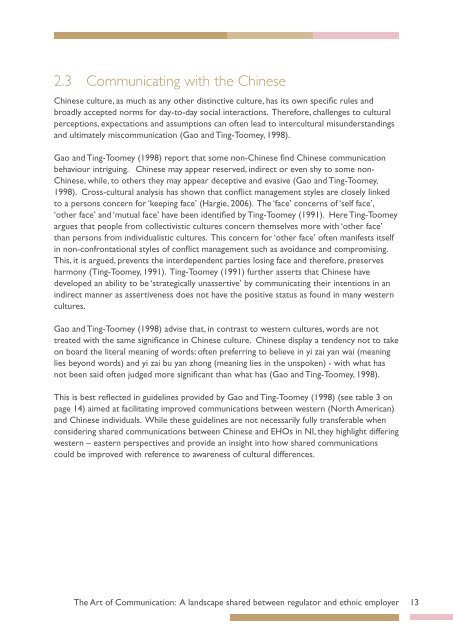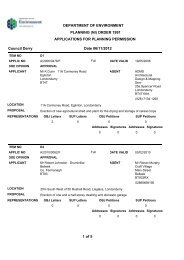The Art of Communication: - Derry City Council
The Art of Communication: - Derry City Council
The Art of Communication: - Derry City Council
You also want an ePaper? Increase the reach of your titles
YUMPU automatically turns print PDFs into web optimized ePapers that Google loves.
2.3 Communicating with the ChineseChinese culture, as much as any other distinctive culture, has its own specific rules andbroadly accepted norms for day-to-day social interactions. <strong>The</strong>refore, challenges to culturalperceptions, expectations and assumptions can <strong>of</strong>ten lead to intercultural misunderstandingsand ultimately miscommunication (Gao and Ting-Toomey, 1998).Gao and Ting-Toomey (1998) report that some non-Chinese find Chinese communicationbehaviour intriguing. Chinese may appear reserved, indirect or even shy to some non-Chinese, while, to others they may appear deceptive and evasive (Gao and Ting-Toomey,1998). Cross-cultural analysis has shown that conflict management styles are closely linkedto a persons concern for ‘keeping face’ (Hargie, 2006). <strong>The</strong> ‘face’ concerns <strong>of</strong> ‘self face’,‘other face’ and ‘mutual face’ have been identified by Ting-Toomey (1991). Here Ting-Toomeyargues that people from collectivistic cultures concern themselves more with ‘other face’than persons from individualistic cultures. This concern for ‘other face’ <strong>of</strong>ten manifests itselfin non-confrontational styles <strong>of</strong> conflict management such as avoidance and compromising.This, it is argued, prevents the interdependent parties losing face and therefore, preservesharmony (Ting-Toomey, 1991). Ting-Toomey (1991) further asserts that Chinese havedeveloped an ability to be ‘strategically unassertive’ by communicating their intentions in anindirect manner as assertiveness does not have the positive status as found in many westerncultures.Gao and Ting-Toomey (1998) advise that, in contrast to western cultures, words are nottreated with the same significance in Chinese culture. Chinese display a tendency not to takeon board the literal meaning <strong>of</strong> words; <strong>of</strong>ten preferring to believe in yi zai yan wai (meaninglies beyond words) and yi zai bu yan zhong (meaning lies in the unspoken) - with what hasnot been said <strong>of</strong>ten judged more significant than what has (Gao and Ting-Toomey, 1998).This is best reflected in guidelines provided by Gao and Ting-Toomey (1998) (see table 3 onpage 14) aimed at facilitating improved communications between western (North American)and Chinese individuals. While these guidelines are not necessarily fully transferable whenconsidering shared communications between Chinese and EHOs in NI, they highlight differingwestern – eastern perspectives and provide an insight into how shared communicationscould be improved with reference to awareness <strong>of</strong> cultural differences.<strong>The</strong> <strong>Art</strong> <strong>of</strong> <strong>Communication</strong>: A landscape shared between regulator and ethnic employer 13
















